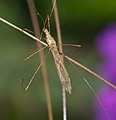Berytidae
| Stilt bugs | |
|---|---|
 | |
| Scientific classification | |
| Domain: | Eukaryota |
| Kingdom: | Animalia |
| Phylum: | Arthropoda |
| Class: | Insecta |
| Order: | Hemiptera |
| Suborder: | Heteroptera |
| Infraorder: | Pentatomomorpha |
| Superfamily: | Lygaeoidea |
| Family: | Berytidae Fieber, 1851 |
| Synonyms[1] | |
| |
Berytidae is a family of the order Hemiptera ("true bugs"), commonly called stilt bugs[2] or thread bugs.[3] Most berytids are brown to yellow, with species that are plant sap feeders, a few being predaceous. About 200 species are known from all around the world and they are classified into three subfamilies.
Description

The Berytidae are extremely gracile insects with legs so long and slender as to suggest common names such as "thread bugs" and "stilt bugs". In this they resemble the Emesinae, with which they are easily confused, though they are in different families. They may be distinguished most readily by the forelegs, that in the Emesinae are raptorial in a way resembling those of the Mantodea, Mantispidae and certain other invertebrate predators. In form and function the forelegs of the Berytidae are roughly similar to those of their other legs. Other differences are subtler and not fully consistent. For one thing, the antennae of most Berytidae though long, geniculate, and in other ways generally similar to Emesinae, tend to have a more or less obvious swelling at the tip. Some members of the family also have slight swellings at the distal ends of the femora of their legs, though in many species this is either absent or not obvious. The head often has a forward-facing protrusion between the antennae bases. The wing membrane has five veins and can be hard to examine in short-winged forms. Some species have spine like protrusions emerging at the base of the forewings which have a pore through which chemicals are secreted. Many species have split or toothed claws which apparently allow, along with the long legs, these bugs to overcome plant defenses involving stick hair on their surfaces. Many species are not purely plant-sap feeding and will opportunistically scavenge on insects trapped on the surfaces of sticky-haired plants.[4] They typically probe all surfaces and can inflict a painful prick on the human skin as well.[5]
Biology
The habits of most species are not well known. Most are believed to be sap-suckers like most other Hemiptera, but some also feed on mites and small insects.[6][7][8]
Subfamilies and selected genera
Three subfamilies are usually recognised:[6]
Berytinae
- tribe Berytini Fieber, 1851
- Apoplymus Fieber, 1859
- Arideneides Tatarnic, 2022
- Bezu Stusak, 1989
- Chinoneides Stusak, 1989
- Neides Latreille, 1802
- Neoneides Stusak, 1989
- Yemmatropis Hsiao, 1977
- tribe Berytinini Southwood & Leston, 1959
- Berytinus Kirkaldy, 1900
Gampsocorinae
Southwood and Leston, 1959
- Bajacanthus Henry & Wall, 2019
- Gampsocoris Fuss, 1852
- Hoplinus Stal, 1874
- Pronotacantha Uhler, 1893
Douglas and Scott, 1865
- Capyella Breddin, 1907
- Jalysus Stal, 1862
- Metacanthus Costa, 1847
- Metatropis Fieber, 1859
- Yemma Horvath, 1905
Unplaced genera
- Acanthophysa Uhler, 1893
- Aknisus McAtee, 1919
- Protacanthus Uhler, 1894
- Paleologus Distant, 1902
Gallery
-
 Stilt bug, possibly juvenile?
Stilt bug, possibly juvenile? -
 Unknown species
Unknown species -
 Stilt bug
Stilt bug - Metatropis rufescens in copula
-
 Stilt bug, Berytidae
Stilt bug, Berytidae
References
- ^ "Neididae Report". Integrated Taxonomic Information System. Retrieved 2018-04-23.
- ^ Thomas J. Henry (1997). Monograph of the stilt bugs, or Berytidae (Heteroptera) of the Western Hemisphere. Entomological Society of Washington.
- ^ Alan Weaving; Mike Picker; Griffiths, Charles Llewellyn (2003). Field Guide to Insects of South Africa. New Holland Publishers, Ltd. ISBN 1-86872-713-0.
- ^ Wheeler, A. G.; Schaefer, Carl W. (1982). "Review of Stilt Bug (Hemiptera: Berytidae) Host Plants". Annals of the Entomological Society of America. 75 (5): 498–506. doi:10.1093/aesa/75.5.498. ISSN 1938-2901.
- ^ Schaefer, Carl W.; Panizzi, Antonio Ricardo, eds. (2000). "Stilt Bugs (Berytidae)". Heteroptera of Economic Importance (0 ed.). CRC Press. pp. 747–758. doi:10.1201/9781420041859-33. ISBN 978-0-429-11838-8. Retrieved 2022-06-13.
- ^ a b Dellapé, Pablo M.; Henry, Thomas J. (2021). "family Berytidae Fieber 1851". Lygaeoidea Species File. Retrieved 2021-10-05.
- ^ "Berytidae". GBIF. Retrieved 2019-06-19.
- ^ "Family Berytidae information". BugGuide.net. Retrieved 2019-06-19.
- v
- t
- e
- Kingdom: Animalia
- Phylum: Arthropoda
- Class: Insecta
- Subclass: Pterygota
- Infraclass: Neoptera
- Superorder: Paraneoptera
Suborder Auchenorrhyncha | |||||||||||||
|---|---|---|---|---|---|---|---|---|---|---|---|---|---|
| |||||||||||||
Suborder Sternorrhyncha | |||||||||||
|---|---|---|---|---|---|---|---|---|---|---|---|
| |||||||||||
| |||||||||||||||||||||||||||||||||||||||||||||||||||||||||||||
















